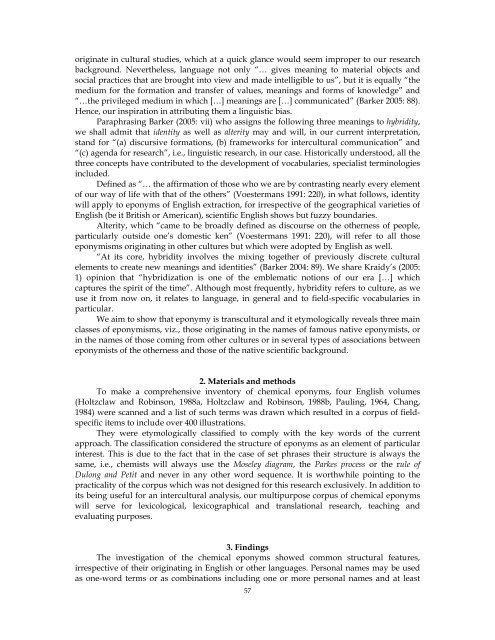You also want an ePaper? Increase the reach of your titles
YUMPU automatically turns print PDFs into web optimized ePapers that Google loves.
originate in cultural studies, which at a quick glance would seem improper to our research<br />
background. Nevertheless, language not only “… gives meaning to material objects and<br />
social practices that are brought into view and ma<strong>de</strong> intelligible to us”, but it is equally “the<br />
medium for the formation and transfer of values, meanings and forms of knowledge” and<br />
“…the privileged medium in which […] meanings are […] communicated” (Barker 2005: 88).<br />
Hence, our inspiration in attributing them a linguistic bias.<br />
Paraphrasing Barker (2005: vii) who assigns the following three meanings to hybridity,<br />
we shall admit that i<strong>de</strong>ntity as well as alterity may and will, in our current interpretation,<br />
stand for “(a) discursive formations, (b) frameworks for intercultural communication” and<br />
“(c) agenda for research”, i.e., linguistic research, in our case. Historically un<strong>de</strong>rstood, all the<br />
three concepts have contributed to the <strong>de</strong>velopment of vocabularies, specialist terminologies<br />
inclu<strong>de</strong>d.<br />
Defined as “… the affirmation of those who we are by contrasting nearly every element<br />
of our way of life with that of the others” (Voestermans 1991: 220), in what follows, i<strong>de</strong>ntity<br />
will apply to eponyms of English extraction, for irrespective of the geographical varieties of<br />
English (be it British or American), scientific English shows but fuzzy boundaries.<br />
Alterity, which “came to be broadly <strong>de</strong>fined as discourse on the otherness of people,<br />
particularly outsi<strong>de</strong> one’s domestic ken” (Voestermans 1991: 220), will refer to all those<br />
eponymisms originating in other cultures but which were adopted by English as well.<br />
“At its core, hybridity involves the mixing together of previously discrete cultural<br />
elements to create new meanings and i<strong>de</strong>ntities” (Barker 2004: 89). We share Kraidy’s (2005:<br />
1) opinion that “hybridization is one of the emblematic notions of our era […] which<br />
captures the spirit of the time”. Although most frequently, hybridity refers to culture, as we<br />
use it from now on, it relates to language, in general and to field-specific vocabularies in<br />
particular.<br />
We aim to show that eponymy is transcultural and it etymologically reveals three main<br />
classes of eponymisms, viz., those originating in the names of famous native eponymists, or<br />
in the names of those coming from other cultures or in several types of associations between<br />
eponymists of the otherness and those of the native scientific background.<br />
2. Materials and methods<br />
To make a comprehensive inventory of chemical eponyms, four English volumes<br />
(Holtzclaw and Robinson, 1988a, Holtzclaw and Robinson, 1988b, Pauling, 1964, Chang,<br />
1984) were scanned and a list of such terms was drawn which resulted in a corpus of fieldspecific<br />
items to inclu<strong>de</strong> over 400 illustrations.<br />
They were etymologically classified to comply with the key words of the current<br />
approach. The classification consi<strong>de</strong>red the structure of eponyms as an element of particular<br />
interest. This is due to the fact that in the case of set phrases their structure is always the<br />
same, i.e., chemists will always use the Moseley diagram, the Parkes process or the rule of<br />
Dulong and Petit and never in any other word sequence. It is worthwhile pointing to the<br />
practicality of the corpus which was not <strong>de</strong>signed for this research exclusively. In addition to<br />
its being useful for an intercultural analysis, our multipurpose corpus of chemical eponyms<br />
will serve for lexicological, lexicographical and translational research, teaching and<br />
evaluating purposes.<br />
3. Findings<br />
The investigation of the chemical eponyms showed common structural features,<br />
irrespective of their originating in English or other languages. Personal names may be used<br />
as one-word terms or as combinations including one or more personal names and at least<br />
57












